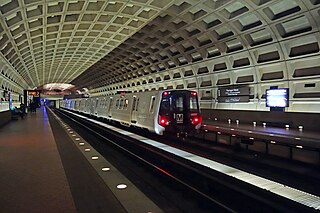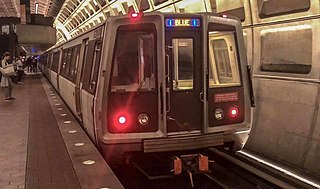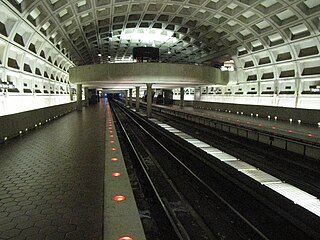
The Washington Metro, often abbreviated as the Metro and formally the Metrorail, is a rapid transit system serving the Washington metropolitan area of the United States. It is administered by the Washington Metropolitan Area Transit Authority (WMATA), which also operates the Metrobus service under the Metro name. Opened in 1976, the network now includes six lines, 98 stations, and 129 miles (208 km) of route.

The Blue Line is a rapid transit line of the Washington Metro system, consisting of 28 stations in Fairfax County, Alexandria and Arlington, Virginia; Washington, D.C.; and Prince George's County, Maryland, United States. The Blue Line runs from Franconia–Springfield to Downtown Largo. The line shares track with the Orange Line for 13 stations, the Silver Line for 18, and the Yellow Line for 7. Only 3 stations are exclusive to the Blue Line.

The Red Line is a rapid transit line of the Washington Metro system, consisting of 27 stations in Montgomery County, Maryland, and Washington, D.C., in the United States. It is a primary line through downtown Washington and the oldest and busiest line in the system. It forms a long, narrow "U," capped by its terminal stations at Shady Grove and Glenmont.

The Yellow Line is a rapid transit line of the Washington Metro system that runs between Huntington in Virginia and Mount Vernon Square in Washington, D.C. It consists of 13 stations in Fairfax County, the city of Alexandria, and Arlington County in Virginia, and Washington, D.C. It is the shortest line in the system, and since its truncation to Mount Vernon Square, it is the only line that does not enter Maryland.

Vienna station is a Washington Metro station on the Orange Line in Fairfax, Virginia. The station is in the median of Interstate 66 at Nutley Street, also known as Virginia State Route 243, in Fairfax.

Dunn Loring station is a Washington Metro station in Fairfax County, Virginia, on the Orange Line. The station is in Merrifield, with a Vienna mailing address. The station is in the median of Interstate 66 at Gallows Road, just outside the Capital Beltway, and is accessed by a footbridge over the eastbound lanes.

West Falls Church station is a Washington Metro station in Idylwood, Virginia on the Orange Line, the first station inside the Capital Beltway on the Orange Line going east. It is one of only two stations in the system to have three tracks, the other being the National Airport station. The center track is used for storage and relaying trains to the adjacent Falls Church Yard.

East Falls Church station is an island platformed Washington Metro station in Arlington County, Virginia, on the Orange and Silver Lines. East Falls Church station is the last aboveground, at-grade, or open-cut station for eastbound trains. East of this station, the trains enter tunnels.

Ballston–MU station is a side platformed Washington Metro station in the Ballston section of Arlington County, Virginia. The station opened on December 1, 1979, and is operated by the Washington Metropolitan Area Transit Authority (WMATA). The station is part of the Orange and Silver Lines and serves the transit-oriented community of Ballston, Ballston Quarter, and Marymount University (MU).

Virginia Square–GMU station is a Washington Metro station in the Virginia Square neighborhood of Arlington, Virginia, United States. The side platformed station opened on December 1, 1979, and is operated by the Washington Metropolitan Area Transit Authority (WMATA). The station serves the Orange and Silver Lines. The station serves the Virginia Square neighborhood as well as the Arlington campus of George Mason University (GMU). The station entrance is located at the intersection of Fairfax Drive and North Monroe Street.

Rosslyn station is the westernmost station on the shared segment of the Blue, Orange, and Silver lines of the Washington Metro. It is located in the Rosslyn neighborhood of Arlington County, Virginia. Rosslyn is the first station in Virginia heading westward from Washington, D.C. on the Orange and Silver Lines and southward on the Blue Line. It is one of four interchange points on the Metrorail system west of the Potomac River and located in a growing business district.

Ballston is a neighborhood in Arlington County, Virginia. Ballston is located at the western end of the Rosslyn-Ballston corridor. It is a major transportation hub and has one of the nation's highest concentrations of scientific research institutes and research and development agencies, including DARPA, the Office of Naval Research, the Advanced Research Institute of Virginia Tech, the Air Force Research Laboratory, and engineering, management, and public sector consulting firms. Ballston also includes a section known as Virginia Square and sometimes the area is collectively known as Ballston-Virginia Square.

The Silver Line is a rapid transit line of the Washington Metro system, consisting of 34 stations in Loudoun County, Fairfax County and Arlington County, Virginia, Washington, D.C., and Prince George's County, Maryland. The Silver Line runs from Ashburn in Virginia to Downtown Largo in Maryland. Five stations, from both lines' eastern terminus at Downtown Largo to Benning Road, are shared with the Blue Line alone; thirteen stations, from Stadium–Armory to Rosslyn, with both the Orange Line and Blue Lines; and five stations from Court House to East Falls Church with the Orange Line alone. Only the five stations of Phase 1, which began service on July 26, 2014, and the six stations of Phase 2, which began service on November 15, 2022, are exclusive to the Silver Line.

McLean station is a Washington Metro station in Fairfax County, Virginia, on the Silver Line. The station is located in Tysons, with a McLean postal address. It began operation on July 26, 2014.

Tysons station is a rapid transit station on the Silver Line of the Washington Metro in Tysons, Virginia. One of four Metro stations in Tysons, it is one of the five stations comprising the first phase of the Silver Line. It opened as Tysons Corner on July 26, 2014.

Greensboro station is a Washington Metro station in Tysons, in Fairfax County, Virginia, on the Silver Line. It opened on July 26, 2014, as part of phase 1 of the Silver Line. Greensboro is one of four Metro stations in the Tysons area and is to be part of the massive regeneration of the district.

Spring Hill station is a Washington Metro station in Fairfax County, Virginia, on the Silver Line. Located in Tysons, it began operation on July 26, 2014. The station is located in the central median of Leesburg Pike just west of Spring Hill Road.

Wiehle–Reston East station is a Washington Metro station in Fairfax County, Virginia on the Silver Line. Located in Reston, the station is situated alongside Reston Station, a mixed-use urban center. Upon its opening, Wiehle–Reston East was the western terminus of the Silver Line with a pocket track just beyond the station for reversing trains until November 15, 2022, when service was extended to the new westernmost terminus at Ashburn station.
The Washington Blvd.–Dunn Loring Line, designated as Route 2A, is a daily bus route operated by the Washington Metropolitan Area Transit Authority between Dunn Loring station of the Orange Line of the Washington Metro and Ballston–MU station of the Orange and Silver lines of the Washington Metro.






















